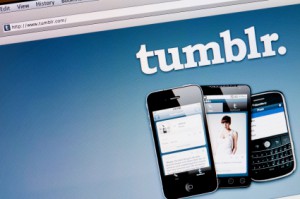 Tumblr is a micro-blogging platform which allows users to post images, videos, text, and sound in a short-form blog. It is a fast-moving distribution system that can expose your content to a global network of 31 million Tumblr blogs. In other words, it is considered one of the easiest ways to blog and one of the fastest ways to go viral on the Internet.
Tumblr is a micro-blogging platform which allows users to post images, videos, text, and sound in a short-form blog. It is a fast-moving distribution system that can expose your content to a global network of 31 million Tumblr blogs. In other words, it is considered one of the easiest ways to blog and one of the fastest ways to go viral on the Internet.
Currently, Tumblr can’t be beat in terms of enthusiasm generated by its users. In September 2011, TechCrunch called Tumblr a “pageview machine” which now has more pageviews than Wikipedia. Tumblr is also bigger than Twitter in pageviews, although not in unique visitors. Part of the reason for its success is that it allows for more creative freedom than Twitter, and more immediate engagement than long-form blogging. In a PRDaily article, Pete Codella wrote: “In the middle of this spectrum, between Twitter and WordPress, is Tumblr.” In the blink of an eye, content from one blog can be copied to hundreds of other blogs.
Media companies are still learning how they can effectively leverage the platform. Because of the visual nature of Tumblr, magazine and style brands are clearly leading the way. Many fashion publications on Tumblr such as Vogue, The New York Times Style section and Glamour see their posts “reblogged” and “liked” by hundreds or even thousands of readers daily. Vogue is the most followed magazine on Tumblr with thousands of fans. According to MediaBistro, Vogue’s newsstand sales are up 16 percent from last year, at a time when the magazine industry is suffering losses in that area. BusinessInsider reported that Tumblrs were probably driving magazine sales but that no one had yet found a way to prove it.
In an email interview, Mark Coatney, director and media evangelist at Tumblr, described the platform as “a network of people all looking for interesting things to do, see, and talk about, so it rewards brands that show off their unique assets.” Traditional news organizations like MSNBC, The Atlantic, The Economist, Mother Jones and UniVision are using that theory to connect with new readers. They use Tumblrs to highlight exclusive content, show off vibrant or vintage photographs, and quickly pump out breaking news. Laura McClure, formerly new media editor at Mother Jones, told BusinessInsider.com that having a Tumblr has been “key in bringing new people to Mother Jones as an organization and as a brand … it’s a different demographic from our usual MotherJones.com website reader or magazine reader.”
It’s evident that Tumblr is another tool media and PR pros can use to enhance the brand and connect. Read about the best ways to put Tumblr to use in Part II of Leveraging Tumblr, including which kinds of content work best. Check back Friday for the second half of our Leveraging Tumblr series.
–Erica Thompson Briggs![]()

